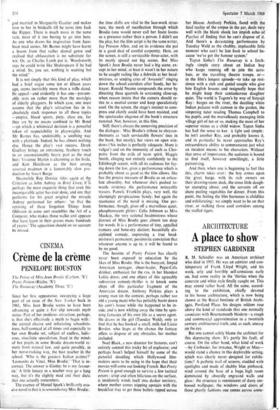A place to show
ARCHITECTURE STEPHEN GARDINER
R. M. Schindler was an American architect Who died in 1953. He was an admirer and con- timporary of Frank Lloyd Wright, and his work, arty and horribly self-conscious early on, had some reality in the 'thirties when the concrete and white style finally caught on. This may sound rather hard. All the same, accord- ing to the exhibition, chiefly devoted to his house architecture, which is now being shown at the Royal Institute of British Archi- tpcts, Portland Place, his designs seldom rose above the kind of standards that one normally associates with Bournemouth Modern—a rough and commercial approximation to a twentieth century architectural truth, and, as such, uneasy on the eye.
But one cannot solely blame the architect for this depressing show. It's partly his fault, of course. On the other hand, what kind of work —by Corbusier, for instance, Wright or Mies— would stand a chance in this deplorable setting, Which was clearly never designed for exhibi- tions? A pathetic trail of screens, studded with spotlights and made of shabby blue pinboard, wind around the base of a huge, high room dominated by absurdly engraved walls and glass: the structure is reminiscent of dusty em- bossed wallpaper, the windows and doors of those ghastly fashions one comes across some- times in prewar magazines and that are best forgotten—the fag-end of art nouveau and neo- classicism.
. So the exhibition organisers—whoever they may be—are • hardly to blame either: they are landed with an impossible interior before they've begun-d-the approach of black fluted columns, distant ceilings floating about among dim lighting, stuffy air—and a building which somehow belongs to the world of bored businessmen and Rotary Clubs; and not to a creative life at all, the life that made amazing buildings like the Divinity School at Oxford, the Queen's House, St Paul's, Blenheim Palace and the Highpoint Flats, Highgate. In consequence, the photographs of Schindler's stark white houses, often naive and crude, lie like bones on the floor of an eerie mausoleum.
This particular man's work is, one imagines, shown exclusively for the attention of archi- tects; but this is not always the case—surely 'exhibitions are put on as part of an ama policy to attract and inform the public? Unfortu- nately, this building is not the place in which to do it. People outside the profession just will not come here, and that is a great pity. Archi- tecture, whatever its period, suffers terribly from under-exposure. Some energetic effort must be made to reverse this situation. Good modern work should be promoted and pub- licised, and exhibitions are the best and most neglected line of communication with the public. People have a right to know what is going on, what architecture is all about, what is bad and so forth. But clearly such exhibitions have got to be held in surroundings which are 'up to date and compatible with what is on show—they Must be attractive, imaginative, ex-
citing. So the RIBA needs to forget its austere
and incongruous buildings in Portland Place for once, and get hold of premises elsewhere, open a special gallery in the West End, say, or perhaps in the King's Road, Chelsea. This could then be fitted up for the purpose, de- signed for today, and exhibitions would change every month or sb and be exposed to frank criticism in the press.
The RIBA, however, will have to look sharp if it is to take the lead in this sphere—as it
should—and therefore remain an influential body. Already others are taking a positive in- terest in modern architecture because they rightly recognise that this is a visual art which affects millions of people, their lives and happi- ness.
Admittedly, some are architects—Hartley, Rubinstein and Thorns, for instance, are pro- posing to open a mixed gallery of architecture and painting as part of a new office arrange- ment—but not all. Mark Glazebrook, the new director of the Whitechapel, comments on the insular and mediocre nature of English design in the current number of -Studio international and suggests a new approach to the ways in which photographs and models, colour aid materials can be presented in his gallery. And why not? Indeed, modern architecture and modern art could easily be shown at the same time; together with sculpture, their subject- matter and aesthetics overlap so much that it seems almost false to separate them. Huge blow-ups of pieces of buildings could make a wonderful natural background for coloured constructions.
And after the Whitechapel, what about the Hayward Gallery and the Ica? I have no doubt that they would show the kind of enthusiasm that is so dreadfully lacking in the architectural establishment



































 Previous page
Previous page